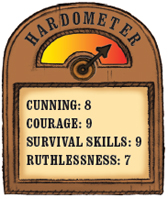

Harriet Tubman escaped from a life of slavery in the United States. Despite huge risks, she fearlessly helped other slaves to freedom too.

A LIFE OF SLAVERY
Harriet was born in about 1820 on a plantation in Maryland. Like the rest of her family, she was a slave, hired out to work by her master from about the age of six. She looked after babies, set traps for pests, and later she worked as a maid and a farm labourer. She was often whipped and beaten by the people she worked for and bore the scars all her life.
ESCAPE!
In 1849 Harriet found out that she was going to be sold. After a failed attempt with two of her brothers, she escaped on her own. During the day she hid from the slave owners who would take her back to her master, where she would face serious punishment. She travelled at night using the Underground Railroad – a network of safe routes and hiding places, where there were people who helped runaway slaves. Eventually Harriet reached Philadelphia, Pennsylvania, where slavery had been abolished.
THE UNDERGROUND RAILROAD
Now a free woman, Harriet worked as a maid and saved her money, but not so that she could settle down. Instead, she put her life in danger again and again in order to help other runaway slaves. She acted as a ‘conductor’, travelling on the Underground Railroad with escaped slaves and helping them to freedom, either in the northern United States or Canada. Runaways and those who helped them risked being re-enslaved, harsh punishments and even death. Even though an enormous reward was offered for Harriet’s capture, she was never caught. By the time the American Civil War started she’d helped dozens – possibly hundreds – of runaway slaves, including her own parents and most of her brothers and sisters.
WAR WORK
During the American Civil War, Harriet served as a nurse, a scout and a spy for the Union army in South Carolina. She was also part of a mission that sailed up the Combahee River to free hundreds of slaves from plantations in South Carolina. Slavery was finally abolished in the United States at the end of the war. Harriet settled in Auburn, New York, with her parents. She lived until 1913 and never stopped working for racial equality and women’s rights.
See here for more about the American Civil War.
![]()
